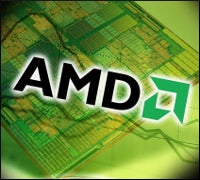 |
Advanced Micro Devices (AMD) posted a fairly heavy loss for the first quarter thanks to falling PC sales but also directly related to its foundry business, which has been spun off as a stand-alone company but is still carried on the AMD books.
AMD’s (NYSE: AMD) net loss for the quarter ended March 31 totaled $414 million, or 66 cents a share. That’s a larger decline from $351 million, or 60 cents a share from a year earlier. Sales fell 21 percent to $1.177 billion.
The net loss was in line with analysts projections of a first-quarter loss of $421.2 million, or 65 cents a share, on sales of $991.3 million, so the firm did beat sales expectations.
This is AMD’s first quarterly earnings report since the company spun off its German fabrication plants in a joint venture with the Abu Dhabi government under the name Globalfoundries. When you take out AMD’s interest in Globalfoundries, AMD (NYSE: AMD) had a loss of just $189 million.
The real problem, though, is failing sales. Right now, the consumer market is the only area of strength, said AMD CEO Dirk Meyer on a conference call with financial analysts. The server business was weak, as were corporate sales. Business are buying only on an as-needed basis.
Like Intel (NASDAQ: INTC) last week, AMD said that inventory has been bled out and the channel is slowly refilling, with desktop product first to bottom out and then laptops. Unlike Intel CEO Paul Otellini, Meyer sees no bottom to this plunge.
“I don’t know how anyone can say we’ve hit bottom, given the uncertainty in the macroeconomic environment,” he said. “The economy is still weak, making it difficult to forecast end-user demand.”
Still, AMD did get something of a bounce. Microprocessor sales were up seven percent from the disastrous fourth quarter of 2008, but they were down 21 percent when compared to Q1 2008. AMD CFO Bob Rivet, also on the call, said the microprocessor division would have shown an operating loss of just $36 million in the quarter.
AMD’s graphics unit, on the other hand, showed across-the-board weakness, with revenue of $222 million, off 15 percent from a year ago and 18 percent from the fourth quarter.
Considering current macroeconomic scenario, limited visibility and seasonality, Rivet expects to be down for Q2 as well. AMD continue to drive toward a break even point of $1.3 billion in revenue for the quarter.
Analyst calls aren’t usually the place for product announcements, but Meyer made three. First, he said that Yukon and Congo, two ultra-portable processors, have begun shipping. Second, he said AMD has moved up the ship date of Istanbul, a six-core Opteron processor, to this quarter.
Finally, he announced a product that wasn’t his: Windows 7. When asked about consumer interest in discrete graphics in laptops, Meyer said “with Windows 7 shipping in the back half of this year, we might see a spike in interest in richer graphics experience.”
Microsoft (NASDAQ: MSFT), on the other hand, continues to insist that Windows 7 is coming next year.


